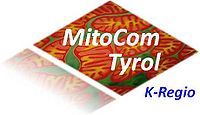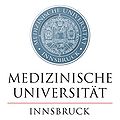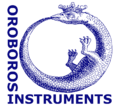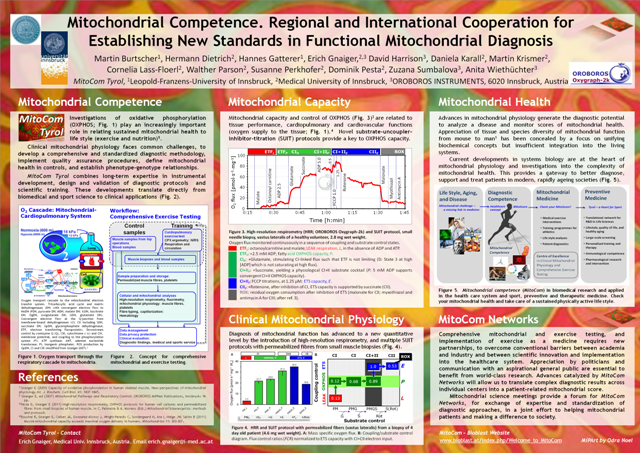MitoCom O2k-Fluorometer
- K-Regio project 2011-2014: O2k-Fluorometer
Willkommen bei MitoCom Tyrol (Deutsch)
K-Regio Project MitoCom O2k-Fluorometer
The aim of the project was the successful development, evaluation and application of a new high-resolution instrument, the O2k-Fluorometer, which builds upon the Oroboros O2k developed and extended since 2001 by Oroboros Instruments and WGT-Elektronik. The O2k provides the instrumental basis for [[High-resolution respirometry] (HRR) and represents world-wide the technologically leading instrument for diagnostic evaluation of mitochondrial respiratory function. The integration of optical devices (O2k-Fluo LED2-Module) into the O2k opens up the potential for the analysis of various diagnostically significant cellular functions, simultaneously with the measurement of mitochondrial respiration. In particular, HRR is now combined with the fluorometric detection of reactive oxygen species (ROS; oxidative stress) and mitochondrial membrane potential using established fluorescent dyes. This innovation further established our technological leadership, and extends a growing market (presently the O2k is represented in 49 countries. The technological ‘sole source’ status is systematically secured, as a decisive feature for the successful world-wide export of a high-end diagnostic instrument.
- Applicant: Medical University of Innsbruck, A.Univ.-Prof. Dr. Erich Gnaiger
- Application: 2011-04-15; Granted: 2011-07-13 (total budget € 1.05 Mill)
- Project duration: 2011-05-01 to 2014-07-31
Financial support
The project MitoCom O2k-Fluorometer was partially supported by K-Regio:
Förderung von Wissenschaft, Forschung und Entwicklung (Programm K-Regio); EU-Regionalförderungsprogramm "Stärkung der regionalen Wettbewerbsfähigkeit Tirols 2007-2013; Landes- und EU-Förderung
EU funding: € 283,295.97
State funding at the expense of the economic funding by the state Tyrol: € 283,295.97
Funding in total: € 566,591.95
Basis of assessment of the fundable costs: € 1,049,010.70
Landesrätin Patrizia Zoller-Frischauf
Partners
The MitoCom consortium consists of 4 members, comprising two Tyrolean SMEs (Oro,WGT), the Medical University Innsbruck (MUI) with three research groups (DSL, HMM, ORT) and the Leopold-Franzens-University Innsbruck (LFU) with one group (ISW).
Dr. Erich Gnaiger (MUI) is the project coordinator, and MUI is the lead partner.
Oroboros Instruments (Oro)
- Oroboros Instruments GmbH (Innsbruck, Austria) provides the world-wide leading concept and technology of high-resolution respirometry applied for the functional diagnosis of mitochondrial defects. The company is fully scientifically oriented, with emphasis on continuous innovation, improvement, scientific support and validation. Oroboros Instruments is established as setting the gold standard in high-resolution respirometry (HRR). The main focus in instrumental development is the combination of the Oroboros O2k with additional electrochemical sensors (simultaneous measurement of pH, NO, mitochondrial membrane potential, Ca2+).
- The O2k is established internationally, with more than 1500 publications (July 2015) in the scientific literature. ORO has organized more than 70 International O2k-Workshops. The close link to the Medical University of Innsbruck emphasizes the direct relation between research and instrumental development. International links are emphasized by the WorldWide MiPNet on high-resolution respirometry - the Mitochondrial Physiology Network (close to 200 Oroboros Reference Laboratories). Cluster Life Sciences Award Tyrol 2010.
- The managing director of Oroboros Instruments GmbH is A.Univ.-Prof. Dr. Erich Gnaiger, who is project coordinator in his capacity as a faculty member of the Medical University of Innsbruck (DSL). Dr. Mario Fasching is the head of the instrumental development group at ORO (senior scientist; 3 years experience with MultiSensor development for the O2k), and is the responsible contact person for the project partner ORO. Our long-term experience in software development for HRR (DatLab) is based on close collaboration with the company Lukas Gradl, software security networks (Innsbruck, Austria). A collaboration on spectrophotometry (redox states of cytochromes) has been initiated in 2008 with Dr David K Harrison PhD (Dundee, UK; Dr Med Habil, Erlangen, Germany; CSci, FIPEM).
WGT-Elektronik (WGT)
- WGT-Elektronik GmbH & Co KG (Kolsass, Tyrol) is specialized in finding optimum electronic solutions for problems not addressed by industrial solutions. Their competence spans from circuit design of analogue and digital electronics, printed circuit board layout, mechanical construction for instruments and electro-mechanical devices, to programming of microcontrollers or PLC-systems. As a diversified company they are capable to deliver a complete electronic instrument as a one-stop solution.
- At WGT the key individuals are Philipp Gradl (CEO, electronic engineer, >20 years experience), Martin Gollner (electronic technician, >20 years experience), and Hannes Schwaninger (Electronic technician, 10 years experience). Dipl. Ing. Thomas Gantioler (specially certified engineer for electrical engineering, >15 years experience) works for WGT on a self-employed basis. WGT collaborates with Oroboros Instruments since 2001.
Lead partner: D. Swarovski Research Laboratory (DSL), Medical University of Innsbruck (MUI)
- Department of Visceral, Transplant and Thoracic Surgery, Medical University of Innsbruck.
- In this project, DSL will provide the scientific expertise in mitochondrial physiology and pathology, for development and application of experimental protocols for functional mitochondrial diagnosis.
- A.Univ.-Prof. Dr. Erich Gnaiger (project coordinator) has scientific and technical expertise in the fields of mitochondrial physiology and pathology, microcalorimetry and biological thermodynamics, contributing fundamentally to the understanding of mitochondrial respiratory control by oxygen, and development and application of high-resolution respirometry to cellular bioenergetics and the diagnosis of mitochondrial defects, particularly in relation to hypoxia, cold storage and ischemia-reperfusion injury. He is initiator (2003) and chairman of the International Mitochondrial Physiology Society, and has organized numerous conferences (particularly MiP2003, MiP2005 and MiP2010 in Austria), workshops (more than 70 international workshops on high-resolution respirometry), and training courses on mitochondrial physiology, bioenergetics and biological thermodynamics, and is editor of several proceedings of international meetings. The international teaching activities range from non-equilibrium thermodynamics for chemical engineers (EU-level training; member of the IUPAC steering committee on biological thermodynamics) to mitochondrial physiology (Innsbruck Summer School 1991; initiator of the MiPsummer Schools 2007, 2008 in Austria; 2009 in Louisiana, US; 2010 in Lithuania; 2012 in Cambridge, UK).
- Dr. Andrea Eigentler has joined the group of E. Gnaiger specifically in the context of the K-Regio Project MitoCom Tyrol, and is responsible for Workpackage 2 (Evaluation of the Instrument in Mitochondrial Applications and Standard Operating Procedures, including application for ethical approval to study human muscle samples obtained during orthopedic surgery; in cooperation with ORT).
Division of Hygiene and Medical Microbiology (HMM), Medical University of Innsbruck (MUI)
- The HMM has a well equipped laboratory with an area of 525 m² and consists of one Full and 4 Associate Professors, 2 University Assistants, several PhD-students, bachelor-students and 5 technical assistants.
- Univ.-Prof. Dr. Cornelia Lass-Flörl heads the Division since 2010. Her research focuses on fungal infections with a special emphasis on the diagnosis, prevention and therapy of invasive infections and antifungal drug resistance. Susanne Perkhofer is university assistant at the HMM. Her research focus is on the interaction of human platelets and antimycotic substances with Aspergillus species, thereby with a main focus on the identification of fungal mitochondrial alterations and mode of actions. Apart from basic equipment needed for standard molecular microbiology and cell culture work the laboratory is further equipped with class 2 tissue culture facilities, a light-cycler for performing quantitative RT-PCR, fluorescence microscope, confocal microscopy, electrophoresis apparatus for RNA/DNA and protein blotting and lab facilities for immuno-histochemistry and Western blotting etc., a FACS and capillary sequencing apparatus. HMM has also an animal facility at the Division where animal studies can be performed.
Departmentof Orthopaedic Surgery (ORT), Medical University of Innsbruck (MUI)
- Univ.-Prof. Dr. Martin Krismer - martin.krismer@uki.at. An ethics committee application will be filed for the experimental use of small samples of muscle tissue (vastus lateralis) derived from hip surgery.
The Institute of Sport Science (ISW), Leopold-Franzens-Universität Innsbruck (LFU)
- The ISW is part of the Faculty of Psychology and Sports Science. The primary objective of the department of sport science is basic and applied research relating to health, performance, and equipment of alpine sports. The research fields include physiology, psychology, biomechanics and motor control. The aspects of alpine sport are explored in an integrated and multidisciplinary approach. All members of the department are focused on the same common goal.
- The focus of the exercise physiology research group is the investigation of exercise responses during alpine sports. In the last years particularly the effects of acute and chronic altitude exposure and intermittent hypoxia on exercise performance were studied in field and laboratory (nomobaric hypoxic chamber) experiments. The biomechanics research group of the department has a long tradition in the development of alpine sports equipment. On behalf or in cooperation with several manufacturers, scientific studies have been undertaken to improve skis, ski bases, ski bindings, ski boots, flex poles, crash protection equipment etc.
- Key techniques available at the department in context of this application are simulation software, ski dynamometers, accelerometers, GPS, measurement systems for the different motor abilities, electromyography, cycle and treadmill ergometers, mobile gas and blood analyzing systems, body temperature and body humidity sensors.
- At the Department of Sport Science the key individuals are Univ.-Prof. DrDr. Martin Burtscher (Director of the Department) and Mag. Hannes Gatterer.
Diagnostic concept
Diagnosis of mitochondrial functions and mitochondrial injuries represents a current challenge for biomedical research and development. ROS production is an essential component of many cell signalling pathways. But ROS also induce oxidative stress in combination with diminished antioxidant capacity, as a potential cause of genetic and functional damage leading to ageing-related degenerative diseases, ischemia-reperfusion injury, and cancer. The direct collaboration and feedback between specialists in mechatronics and biomedical science is of eminent importance for the targeted development, evaluation, and optimization of the new O2k-Fluorimeter, complete with protocols, instructions for quality control, and references to applications in sports science and clinical diagnosis.
Mitochondrial competence will play an increasing role in therapeutic and preventive medicine, with exercise and caloric balance providing the most effective measures for the reduction of several age-related health risks and degenerative diseases. MitoCom Tyrol is a gateway and milestone to better diagnose, support and treat patients in our modern, rapidly ageing society.
Mitochondrial competence. Regional and international cooperation for establishing new standards in functional mitochondrial diagnosis
Martin Burtscher,1 Hermann Dietrich,2 Hannes Gatterer,1 Erich Gnaiger2,3,* David Harrison,3 Daniela Karall,2 Martin Krismer,2 Cornelia Lass-Floerl,2 Walther Parson,2 Susanne Perkhofer,2 Dominik Pesta,2 Michael Schocke,2 Zuzana Sumbalova,3 Anita Wiethüchter3
MitoCom Network Tyrol, 1Leopold-Franzens-University of Innsbruck,2Medical University of Innsbruck, 3Oroboros Instruments A-6020 Innsbruck, Austria
- Email: erich.gnaiger@i-med.ac.at; Tel: +43 512 566796; Fax: +43 512 56679620
This is an Abstract presented at UMDF Mitochondrial Medicine; 2011 June 15-18, Chicago, USA
Diagnostic methods for the evaluation of functional mitochondrial competence (MitoCom) are applied in diverse areas of clinical research, including inborn diseases, ageing, degenerative neuromuscular disorders, ischemia, cancer, and pharmatoxicology. Such investigations of oxidative phosphorylation (OXPHOS) play an increasingly important role in relating mitochondrial health to life style (exercise and nutrition), mitochondrial haplogroups and heteroplasmy, and individual training programs of competitive athletes.
Clinical mitochondrial physiology shares common problems: lack of a comprehensive and standardized diagnostic methodology, limited implementation of quality assurance procedures, and the difficulty of delineating healthy controls. Without a more complete understanding of the mitochondrial physiology in tissues of healthy humans and animal models, there is limited diagnostic potential to analyze a disease and monitor scores of mitochondrial health. Appreciation of tissue and species diversity of mitochondrial function from mouse to man1 has been concealed by a focus on unifying biochemical concepts but insufficient integration into the living systems. This is the challenge of present developments in systems biology, which is at the heart of mitochondrial physiology as applied to enhancing our understanding of the complexity of mitochondrial health, and which will provide a gateway to better diagnose, support and treat patients in our modern, rapidly ageing societies.
Mitochondrial capacity and control of OXPHOS (oxygen consumption and ATP production)1 needs to be related to tissue performance (PCr depletion and Pi accumulation by 31P-NMR, contractile muscular function and PCr recovery), and cardiopulmonary and cardiovascular functions (oxygen supply to the tissue).2 The need for such interdisciplinary efforts, has led to international studies to investigate the complexity of the respiratory cascade from lung to the intracellular environment together with the mitochondrial electron transfer and phosphorylation system.3 Translation into the clinical diagnostic setting requires the establishment of regional centers with inter-departmental cooperations and new partnerships, to overcome conventional barriers between academia and industry and between scientific innovation and implementation into the healthcare system (www.bioblast.at/index.php/MitoCom). Appreciation by politicians and communication with an aspirational general public are essential to benefit from world-class research, for comprehensive mitochondrial and exercise testing and implementation of exercise as a medicine, and the development of a scientific foundation that may allow us to translate the complex diagnostic results into a patient-related mitochondrial score, based on cooperation in regional and international mitochondrial networks, exchange of expertise and standardization of diagnostic approaches, in a joint effort to helping mitochondrial patients and making a difference to society.
2Burtscher M, Schocke M, Koch R (2011) Ventilation-limited exercise capacity in a 59-year-old athlete. Respir Physiol Neurobiol 175:181-4.







